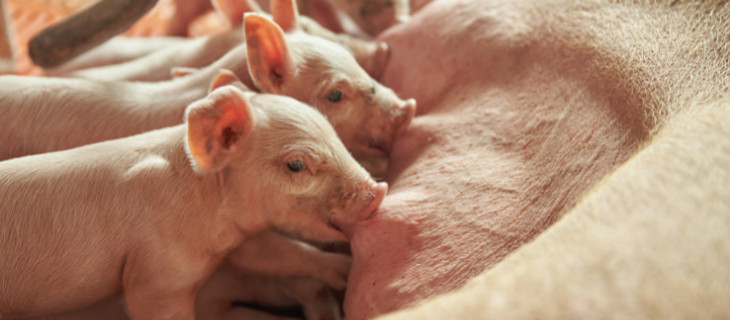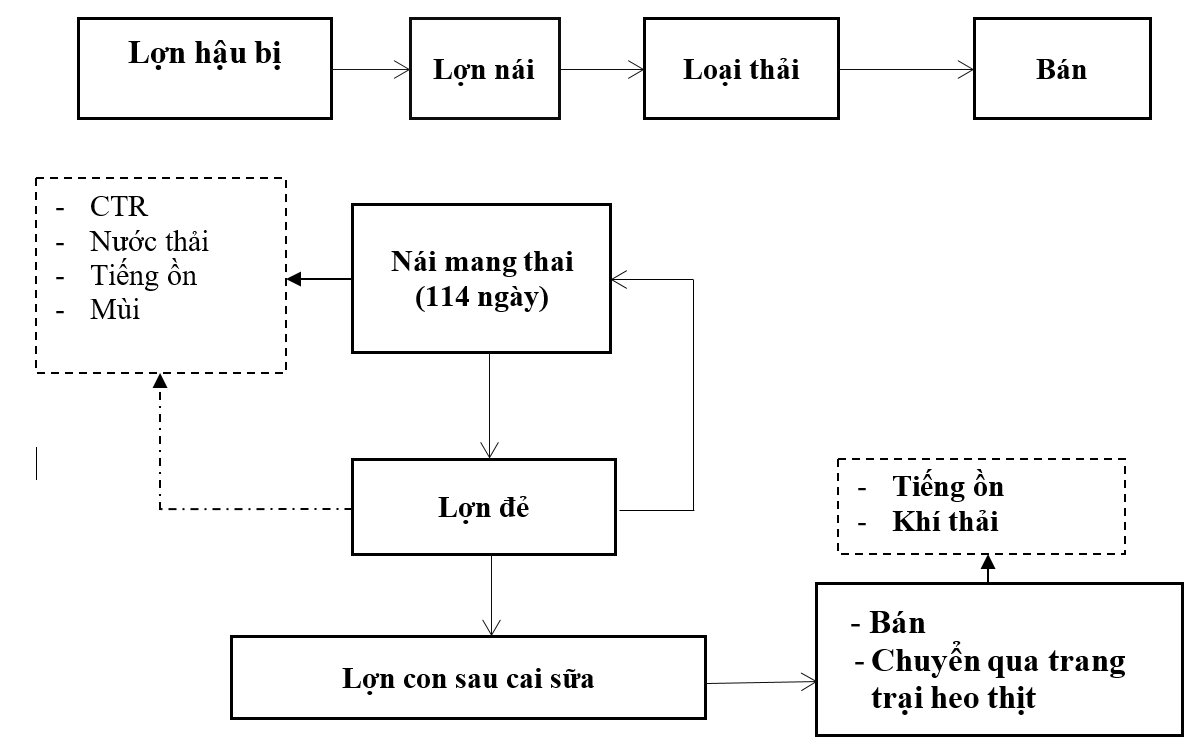NUTRITION FOR HIGH YIELDING SOWS

 Trends and problems of high yielding sows
Trends and problems of high yielding sowsRaising high yielding sows in farms is a common trend nowadays due to high reproductivity, high PSY (number of weaned piglets per sow per year), which determines the profitability of farmers (Ocepek M, 2017). For the last 20 years, we have increased by 0.2 PSY, increasing the number of piglets born alive and weaned from 10.2-13.8 and 9.1-12.6 heads per sow (BdPorc, Spain, 2020). However, there is a negative correlation between the number of piglets born alive and birth weight. Sows with high fertility usually deliver piglets with small birth weights. If the piglets do not receive improper nutrition, it will take longer to wean and raise them, which increases costs and decreases profits (SEGES, 2018).
Another challenge is that high yielding sows eat less and do not have enough nutrition for milk production, which increases the weight loss of sows during lactation (15-20% of body weight) (Eissen et al. al., 2000), thereby reducing the number of reproductive cycles, increasing time for sows to breed after weaning, and reducing the reproductive performance of the next litter (Knox RV, 2020).



 CJ's technology in nutrition for high yielding sows
CJ's technology in nutrition for high yielding sowsCJ Vina Agri has applied new technologies in sow feed products to improve feed intake, increase energy metabolism, supplement artificial milk for piglets, thereby minimizing weight loss of sows and improving uniformity and post-weaning weight of piglets.
- Applying PMEI technology in processing raw materials to remove anti-nutritional factors, gelatinize starch, break protein and fat envelope to increase protein and amino acid digestion, improve absorption and milk production.
- Applying HIGH-CARBOHYDRATE DIET with the optimal ratio of ingredients to increase insulin and LH secretion to make it faster for sows to come into heat again after weaning and increase the number of eggs released. In addition, this technology also reduces the weight loss of sows and increases the weight of weaned piglets by increasing the glucose content in the blood and milk.
- Using CJ Bio's NEW GENERATION ENZYMES in the diet to improve the digestion of NPS (Non starch polysaccharide); phytate; destroy the bonds covering nutrients, thereby improving the appetite of and feed intake of sows.
 Sow raising process
Sow raising process- Sows weighing 120kg will be selected, the first 600 heads out of which will be selected for mating, the remaining will be mated after 1 month.
- QThe mating process lasts for 3-5 days, and sows get pregnant after 18-21 days. The gestation period is 114 days (3 months + 3 weeks + 3 days) ± 3 days.
- Newborn piglets are cleaned right after delivered. After 3 days, their tails are cut off and their ears are pierced for tracking numbers.
- Piglets will be weaned after 21 days, 6,000 heads out of which will be selected for raising market hogs and the rest will be sold to the market.

 Overview of MMA in sows
Overview of MMA in sowsPostpartum reproductive disorders are common and complicated diseases in sows worldwide. These disorders are commonly referred to as mastitis, metritis, agalactia (MMA), and postpartum dysgalactia syndrome (PPDS). MMA usually occurs within 3 days of birth, reduces the reproductive performance of sows, and increases the number of dead piglets. Piglets are completely dependent on colostrum and mother's milk for survival and growth, the first 3 days after birth is the most important period for the survival of piglets. Lack of milk triggers starvation and hypothermia in piglets, thereby making them dead.
- Mastitis: is an inflammation of breast that involves an infection caused by E.coli bacteria. In many cases, only one or two mammary glands get infected. Mastitis can also be caused by metritis.
- Metritis: is an inflammation of the uterus occurred in the endometrium during the delivery of piglets. The symptoms of metritis is white pus discharged from the vulva.
- Agalactia: is reduction in milk production which is usually hard to detect until piglets show signs of starvation due to lack of milk.
 Causes and mechanisms of MMA in sows
Causes and mechanisms of MMA in sows
 Symptoms of MMA in sows
Symptoms of MMA in sowsSows with MMA syndrome often show signs of constipation, fever of above 39,5oC, and decreased feed intake for 1-2 days. The sows lose their appetite, have psychological restlessness, lie on their stomachs and hide their udders on the floor. Sometimes they have so much pain that they cannot feed piglets. Sometimes they show few individual symptoms but sometimes they show all (mastitis, metritis, agalactia). The breast is hard, swollen, red, painful when being touched. The sows produce less milk. There is milky white stinky pus discharged from the vulva.

 Treatment of MMA in sows
Treatment of MMA in sows- Douching of uterus with 0.1% potassium permanganate solution with a dose of 2-4 liters/head once a day, continuously for 3-5 days. Insert or inject antibiotic including Peniciilin, ampicillin, tetracycline into the uterus after douching.
- Injection of antibiotics including Ampicillin, Amoxicillin. Give sows additional injections of Oxytocin or Lutalyse and Calcium Gluconate to stimulate the mammary system to improve milk production of lactating sows.
- Provide the sows with vitamin C, supplementary food, antipyretic.
 Prevention of MMA in sows
Prevention of MMA in sows- Give sows thorough showers before putting them in the farrowing house. The farrowing house must be kept clean and dry all the time when the piglets are with the mother.
- Regular exercise of sows also reduces MMA syndrome.
- During pregnancy, it is required to control the diet of sows to stop them from being overweight.
- Make sure there is always enough clean water for the sows to drink at all times.
- The farrowing house must be kept quiet and cool to reduce stress for the sows during farrowing.
 “Transition Diet” for high yielding sows
“Transition Diet” for high yielding sowsThe transition period between the end of the gestation to the beginning of the lactation is short (from the 105th day of the gestation to the 5th day of the lactation) but is very important to the performance of high yielding sows. During this period, significant physiological and biochemical changes occur in a sow’s body due to the rapid development of the fetus, the growth of the mammary glands, colostrum production, and the changes caused by the maintenance of the body. Usually, nutritionists only develop two different formulas for the 2 stages of pregnancy and lactation, respectively. However, it is required to identify at least 3 stages of a reproductive cycle requiring 3 different diets and including pregnancy - transition - lactation to fully meet the needs of high-yielding sows (Feyera et al., 2017; Batson et al., 2018; Holen et al., 2020).
Many studies have shown significant effectiveness when applying a 'transitional diet’ compared to traditional 2-phase programs. In cases of sows fed with the 'transitional diet’, the average weight of alive newborn piglets increases by 2.7-3.2%; the average weight of weaned piglets increases by 0.6 kg, the number of piglets and the average weight of market hogs delivered by a sow per year increase by 0.75 and 50kg respectively, the stillbirth rate or the rate of piglets dead within 24 hours after being delivered decreases by 2.5-3.5%, it takes 19.5 minutes for a saw to deliver piglets on average; the rate of having constipation in sows reduces from 14.67% to 5.78% (Miller et al., 2020; Gourley et al., 2020; CJ R&D center, 2020; 2021).


Effects of use of transition diets (PIG PROGRESS, 2020)
CJ’S TECHNOLOGY
CJ Vina Agri has applied new technologies in producing 'transitional' feed for sows to precisely meet the nutritional needs and suit the physiological and biochemical changes of the sows during this special period, thereby increasing productivity and maximizing profits of farmers.
- Apply AA BALANCING LOW PROTEIN diet technology in accordance with the ideal protein sample combining 8 amino acids synthesized by CJ Bio (Lys; Met; Thr; Try; Val; Arg; His; Iso-Leu) and the optimal ratio of standardized ileal digestible /net energy (SID AA/NE) to accurately meet the sows’ demand for amino acid during this period without increasing crude protein content and minimizing the discharge of excess nutrients to the environment.
- IMMUNITY BOOSTER supplemental package extracted from natural products has the effect of activating the intestinal antibody system, detecting and quickly destroying pathogens invading from the digestive tract, and enhancing the resistance of piglets and sows.
- NUTRIENT BALANCE package with dEB (dietary Electrolytes Balance); omega 3 & DHA; soluble/insoluble fiber (fCHO/iCHO) and optimal calcium content will improve piglets’ vitality and survival, reduce oxidative stress of sows during parturition, and enhances the production of milk and colostrum to get the sows ready for lactation.



